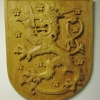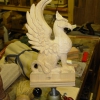
| 07 May 2023 16:44
This is such a fantastic series. Thank you for so generously sharing knowledge.

| 15 September 2021 11:33
Imran - How the abrasive marks appear depends on the state of the bevel when you offer it to the stone, which you do at around 15-20deg, the cutting angle.
1. If the bevel of your tool is too 'fat' an angle, the abrasive marks will initially be on the heel. As you keep the angle at which you present the tool to the stone constant (to produce a flat bevel), these marks will creep towards the cutting edge, and the bevel will get longer.
2. If the bevel of your tool is rounded, the abrasive marks will initially be in the middle (on the 'top of the hill', so to speak). As you keep the angle at which you present the tool to the stone constant (to produce a flat bevel), the abrasive line will widen and creep towards both the heel and the cutting edge.
3. If the bevel of your tool is initially set at too acute an angle, the abrasive marks will start at the cutting edge. You need to pull back that cutting edge (squaring off) so that you have metal in the bevel to work with.
At some point the abrasions should be - as you say - evenly distributed from cutting edge to heel so you have a flat bevel. However, this may not happen until you have worked on it a bit. Ideally, you will have created a pretty flat bevel at the correct angle on the grinder first ('shaping') before moving on to the stone so you get to this flat distribution of abrasions quickly and can start attenuating the white line of the cutting edge.

| 14 September 2021 17:42
Hi Chris. Thanks for the video. The question pertains to the abrasive marks on the gouge created by the bench stone. As one starts this process are the abrasions supposed to be seen distributed symmetrically from the heel to the edge after a couple of passes on the stone, or are these gradually progressing from heel towards the edge of the tool? Thanks

| 28 June 2020 09:01
Reginald - Yes, you are on the right track: the stiffer the strop surface, the less deflection as the tool passes over, and the less rounding of the bevel. The issue is getting the abrasive to stick to the strop; I've never found wood holds it well. And I'm not sure about the wear with cardboard.
The best solution, one that gives the best of both worlds, would seem to be very thin leather glued to wood.

| 27 November 2015 16:55
Lino - I think you said it: "the practical whatever gets us to the end result approach". In other words, try it and see! There are many ways to achieve the end result and, really, that's what's important: having a good sense of what you are aiming for, what the carving tool should look and feel like. My only reservation is that sandpaper must wear rather quickly compared to conventional stones and slipstones but it won't cost much to experiment...

| 26 November 2015 04:06
Hi Chris, Just joined and am really enjoying the videos and your teaching method, particularly the practical whatever gets us to the end result approach. That said, I employ diamond stones for my woodworking chisels and would like to stick to those for my carving tools. Any thoughts on utilizing a self-made routed or carved curved edged mdf square, or simply a dowel, wrapped in sandpaper to shape and sharpen inside bevels? Also in regards to an alternative for the grinding wheel, what about a course sandpaper such as 80 grit on a flat surface like plate glass for the initial shaping before a course 240 grit stone?

| 16 April 2014 07:30
Ian - I haven't really got too much to say about the burr. It's also known as a 'wire' or 'feather' edge and it arises when you've oversharpened one side of the bevel or the other. If you don't remove it with the stones down to smooth metal, it's likely to break off and leave scratches in the wood - you'll see it as the white line, the visible edge. Sometimes, when you think you've got rid of the 'white line', it's actually a little bit of the burr angled over so the light on the edge is not reflected. Pushing the blade into soft wood removes any burr and effectively toughens or cleans up the edge, and gives you a chance to see any white line and hone it away. HOOK KNIVES - I'll make a note of that and we'll include them when the opportunity presents itself - can't say when, sorry.

| 15 April 2014 07:46
Hi Chris,
Awesome effort, spent a happy day watching as many video as possible. As i teacher I admire your articulate ,clear and pleasant narration. Craftsmanship inspirational.
I have been a student of sharpening for many years in the disciplines of traditional woodwork and bushcraft, with a special interest in burr removal. You seem to do several thing to remove the burr, breaking it off in a piece of wood, alternating inside outside bevel honing and stropping. What are your thoughts on burr removal and do they ever cause you trouble. What is the theory on toughening up the edge, which you mentioned a couple of times.
I see that Carrie uses hook/crooked knives. and a video showing sharpening these would help spoon carvers etc
best wishes
Ian

| 20 May 2013 07:11
Jon - Never had the success, or access to the variety of slipstones, that i have with the translucent Arkansas. And diamond will wear out, whereas you can flatten and reshape the stone. Still, it's whatever works and if you can get the edges and profile you want with the diamond equipment, job done - on with the carving!

| 19 May 2013 20:02
What do you think of coarse and fine diamond whetstones and slips for sharpening?

| 12 January 2013 15:59
Bill - That's a good suggestion. Sharpening is covered in my books too. Here I've rather been hoping for individual issues, rather than more general stuff. However, a sort of '101-Crib Notes' lesson might be a good idea - the absolute key point on which everything else rests. I cannot say when it will appear but I will certainly look at that.

| 29 December 2012 06:42
David - There's no advantage and the Arkansas is a lot more expensive. So, unless you have a coarse white Arkansas stone, I'd buy the India.

| 27 December 2012 17:59
Hi Chris, I am currently using diamond and ceramic bench stones. I am thinking of going with Arkansas bench stones. I see you use an India stone for your coarse stone, would a soft Arkansas stone work as good as an India stone for my coarse stone?

| 05 November 2012 10:14
Oscar - SLIPSTONES: There's a range of widths in the slipstones to cope with different widths of gouges. You can't, say, fit the #9 edge of the 3/4" slipstone into a 1/2" #9 gouge (though you could fit it into flatter narrower gouges). The best thing is to buy one set, say the 3/4" and see how you get on; the others are there if you need them. PFEIL: There are 2 things you want to ensure - (1) the low cutting angle (2) an adequate, ie. significant, inside bevel - while maintaining the shape and sharpness of the cutting edge. If you can do this without cutting back the edge and doing the full work over as I show you in the DVD, then sure, no problem!

| 05 November 2012 05:19
Hi Chris,
Great info. A couple of questions, one I notice your signature stones are sold at 1/8", 1/2" and 3/4" thickness, can we buy just the 3/4" and use it on all the different width gouges?
Two, I just bought a bunch of new Pfeil chisels.. Sort of making a small set for myself. Can I just take them and put a back bevel on them and not deal with a complete do over on the edge?
Thanks,
Oscar

| 13 May 2012 12:21
Hi Chris, Excellent instruction and very smart to have a 'novice' to ask those 'obvious' questions on the viewers behalf.

| 05 May 2012 12:02
Rob - There is only one bevel on a carving tool, unlike bench chisels which have 2 (at grinding and honing angles). So, yes, grinding angle becomes cutting angle.

| 04 May 2012 10:41
Hi Chris, I would like to know whether the grinding angle of approximately 20-25 degrees is the same as the cutting angle. In other words does the grinding angle become the cutting angle? Many thanks, excellent video and it is great that you have Rob asking questions invaluable!

| 30 April 2012 11:59
Sandy - Point well taken, and thanks for making it! I was indeed speaking from personal experience but I agree that that 'off the cuff' thought would have been better left out or, better, more helpfully made as a full generalisation: We should be seen as individuals and taken on our own merits. One of the things I love about carving is its very wide and pretty level playing field.

| 29 April 2012 18:29
I hesitate to make one of the first comments on the new sharpening video one about your comments about women carvers. But here I go anyway. Please do not get me wrong, I do not take offense easily, and certainly none taken here. However, I think that I may be an exception as far as a woman woodworker. It is entirely possible that other women may not be as receptive. Personally, I do not hold to a tight political correctness. I have worked construction nearly 40 years and I have the vocabulary to prove it LOL. I understand that your experience is just what you expressed in the video and I have encountered it also. But your point, in the future, might be better received by making more of a generalize comment about the fear of grinders. I have known men who were afraid of power tools as well. On a lighter note, I got a great deal out of the video series and am employing the proper method of sharpening. Thanks, Sandy